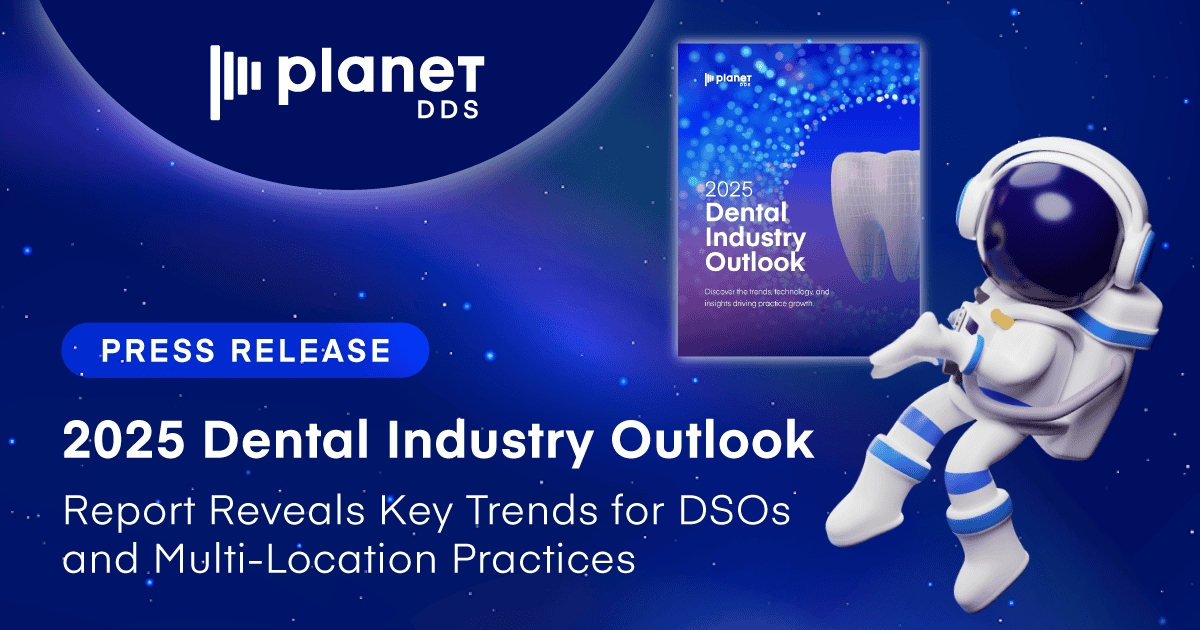Top 15 Dental Industry Trends Driving Growth in 2025

With new advancements and shifting patient expectations shaping the future of dentistry, staying up-to-date on the latest dental industry trends is vital for practices looking to grow and deliver top-tier care. Practices must continuously adapt to these changes to optimize their operations and meet evolving patient needs.
Understanding the current trends in dentistry is not only about staying relevant but also about improving practice management, patient satisfaction, and operational efficiency.
In 2025, the dental industry continues to experience transformative shifts. From leveraging AI-powered tools to integrating digital workflow systems, dental practices are finding new ways to deliver high-quality care while managing resources effectively. These dental trends offer a pathway to future success, ensuring dental practices can thrive and grow in the future.
15 Top Dental Trends for 2025
In 2025, dental practices are prioritizing innovation and operational efficiency. The following dental industry trends outline the key changes driving growth and enhancing practice management:
1. AI and automation in dentistry
Artificial intelligence (AI) is rapidly transforming dental practices. AI-powered software assists in diagnostics, treatment planning, and patient interactions. For example, AI tools can interpret dental X-rays, such as detecting cavities or gum disease, with high precision. Chatbots and virtual assistants are now handling routine tasks like scheduling and answering patient inquiries, allowing dental staff to focus on higher-priority tasks.
The integration of AI and automation streamlines operations, reduces human errors, and improves patient outcomes. Dental practices that adopt AI benefit from reduced administrative burdens, better diagnostic accuracy, and enhanced patient care. As dental offices increase in size and patient numbers, AI dentistry trends will play an increasingly vital role in maintaining operational efficiency.
2. Telehealth and teledentistry expansion
Telehealth has become a permanent feature of the healthcare industry, and dentistry is no exception. Patients now expect the convenience of virtual consultations, and dental practices are adapting by offering teledentistry services. These services allow patients to have initial consultations, follow-ups, and even diagnostic assessments remotely.
Teledentistry expands a practice’s reach, enabling access for patients in rural areas or those with mobility challenges. This not only reduces no-shows but also maximizes the efficiency of in-office visits. By adopting telehealth, dental practices can offer more flexible scheduling options and build stronger patient relationships by providing ongoing care without the need for frequent office visits.
3. 3D printing for custom dental solutions
3D printing continues to revolutionize the production of dental prosthetics such as crowns, bridges, and dentures. Practices equipped with 3D printers can now create these items in-house, eliminating the need for external labs and significantly reducing wait times. By 2030, the global market for 3D printing in dentistry is projected to reach 15.9 billion.
This technology not only increases the speed of production but also enhances customization, enabling practices to create more precise and personalized prosthetics. The result is improved patient satisfaction and more efficient workflows, as practices can deliver same-day solutions to their patients.
4. Group practices and DSO growth
The growth of dental service organizations (DSOs) and group practices is reshaping dental industry trends. More practices, particularly those led by younger dentists, are joining DSOs to benefit from shared resources and reduced operational risks. DSOs offer services such as marketing, human resources, and administration, allowing dentists to concentrate on clinical care.
By joining DSOs or forming group practices, dentists can take advantage of economies of scale, better negotiate with suppliers, and access the latest technology. This trend is expected to continue driving industry consolidation, making DSOs a critical factor in the future of dental practice management.
5. Patient-centric dental care
Patients are increasingly demanding convenience in their dental care. Dental practice owners who offer online appointment booking, digital payment options, and extended office hours are gaining a competitive edge. According to recent data, 95% of patients would prefer to book dental appointments online if given the opportunity.
Practices are responding by adopting technology that allows patients to schedule visits and make payments from their smartphones. Additionally, offering evening and weekend appointments helps cater to patients with busy schedules. Providing these conveniences not only improves patient satisfaction but also boosts practice efficiency by reducing missed appointments and optimizing staff utilization.
6. Focus on digital patient engagement
In an increasingly digital world, patient engagement is a top priority for dental practices. Digital engagement strategies include using social media, email campaigns, and patient portals to keep in touch with patients and provide them with educational content. Studies indicate that 58% of dental patients prefer video content from their dentist, while over 30% engage with dental practices on platforms like Facebook.
By leveraging these digital tools, dental practices can increase patient loyalty, attract new patients, and improve the overall patient experience. Regular communication through these channels helps keep patients informed and engaged, resulting in higher retention rates and a more personalized care experience.
7. Staffing challenges and solutions
Staffing shortages remain a significant challenge for dental practices in 2024, with 60% of dentists expressing concerns about recruitment and retention. Practices are turning to automation and outsourcing to alleviate some of these pressures, allowing staff to focus on patient care.
In response to staffing challenges, practices are also focusing on improving workplace culture, offering competitive salaries, and implementing flexible work schedules. By addressing these staffing issues head-on, dental practices can improve employee retention and ensure that they have the necessary resources to meet patient needs.
8. Adoption of digital workflow systems
Digital workflow systems are becoming an integral part of modern dental practices. These systems, which include electronic health records (EHR) and cloud-based practice management software, streamline administrative tasks, such as billing, scheduling, and patient communication.
By digitizing workflows, practices can reduce the risk of manual errors, improve efficiency, and ensure better communication with patients. Digital workflows also allow dental teams to collaborate more effectively, enhancing the overall quality of care and operational efficiency within the practice.
9. Predictive analytics for operational efficiency
Predictive analytics is gaining traction as dental practices look to improve operational efficiency. By analyzing patient data, practices can forecast appointment demand, optimize staffing schedules, and reduce no-shows. This data-driven approach helps practices allocate resources more effectively and make informed decisions that boost both productivity and profitability.
Practices using predictive analytics are better equipped to anticipate patient needs and adapt to fluctuations in demand, ensuring smooth operations and higher patient satisfaction. This proactive approach is essential for scaling dental practices in a competitive market.
10. Subscription-based dental services
The growing demand for subscription-based dental services is transforming how dental practices manage patient care. These models offer patients the option to pay a fixed monthly or annual fee for comprehensive dental services, including cleanings, exams, and even discounts on major procedures. Studies show that 83% of patients are more likely to stay with a dental practice that offers an in-house membership plan.
For dental practices, subscription models provide a predictable revenue stream and help reduce dependence on insurance reimbursements. These plans also encourage regular patient visits, improving preventive care and long-term patient retention.
11. Virtual consultations and remote monitoring
Virtual consultations are becoming increasingly popular, offering patients a convenient way to access dental care without having to visit the office. This trend, coupled with remote monitoring, enables dental professionals to track patient progress for dental treatments like orthodontics without requiring frequent in-office checkups.
Virtual consultations enhance patient accessibility and reduce the administrative burden on practices, leading to more efficient operations. This trend allows dental professionals to maintain strong relationships with patients and ensure treatment compliance without the need for regular in-person visits.
12. Patient retention and loyalty programs
In an increasingly competitive dental market, DSOs and private practices are focusing on patient retention by offering loyalty programs and personalized communication. Loyalty programs incentivize patients to return to regular care and promote long-term relationships between the practice and patients.
For dental practices, retention strategies help improve patient loyalty and ensure steady revenue. By offering incentives such as discounts on services or special offers, practices can keep patients engaged and encourage ongoing care.
13. Mobile app integration for patient engagement
Mobile apps are becoming an essential tool for patient engagement, allowing patients to book appointments, make payments, and access treatment information from their smartphones. Offering an app enhances the patient experience by providing added convenience, making it easier for patients to stay connected with their dental care.
Mobile apps also help improve patient compliance by sending reminders for upcoming appointments and post-care instructions. Dental practices that invest in mobile app technology will see greater patient satisfaction and retention.
14. Data security and HIPAA compliance
As dental practices increasingly rely on digital tools and patient data, ensuring data security and HIPAA compliance is critical. Practices must prioritize cybersecurity measures to protect patient information and avoid breaches.
Investing in secure software solutions and regular staff training on HIPAA regulations ensures that patient data is safeguarded. Practices that prioritize data security not only protect themselves from legal and financial risks but also build trust with their patients.
15. Outsourcing non-clinical tasks to improve efficiency
To optimize operations, many dental practices are outsourcing non-clinical tasks such as billing, marketing, and administrative work. By outsourcing these functions to specialized service providers, DSOs and dental practices can reduce overhead costs and focus on patient care.
Outsourcing non-clinical tasks enables dental teams to streamline their operations, improve profitability, and enhance the overall patient experience by allocating more resources to clinical care.
Adapt to Dental Industry Shifts in 2025
Implementing these dental industry trends is crucial for practices aiming to succeed. By embracing AI, enhancing patient engagement, adopting digital systems, and exploring new care models, dental practices can ensure they are well-positioned to thrive in a competitive market. For practices to achieve sustainable growth, staying informed about innovations in dentistry will make all the difference.



